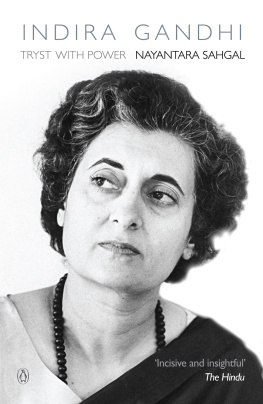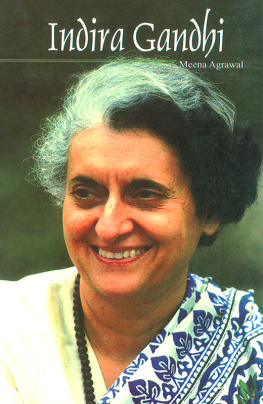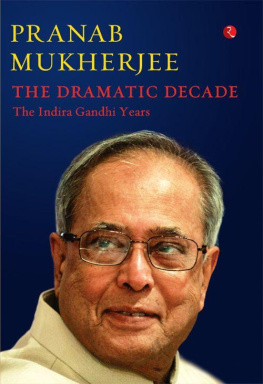As I Saw It
This book originated with a paper I was asked to contribute on Indira Gandhis political style for a conference on Leadership in South Asia at the School of Oriental and African Studies, University of London, in March 1974. It was expanded and published in its present form in 1982. It traces the events in the Congress party and the country that represent a break with the style that had been a feature of the historic Congress.
Congress politics had worked within the framework of democratic institutions, encouraging open and diverse expression and debate both within the party and between the ruling party and the Opposition. Indira Gandhis creation of a highly centralized governing apparatus and party machine under her personal command had the effect of reversing this process. Under the authoritarian rule of the Emergency of 197577, it ended altogether. Why events should have taken this turn is perhaps the effect of personality on history.
The book I wrote dealt almost entirely with the developments that transformed the historic Congress party and the Indian polity, and it owes its tone to the intense anxiety I felt at what was happening in the country. It remains relevant as a reminder that democratic institutions and practices, even in a nation established in democracy, need guarding against assault and subversion. The Emergency itself was a watershed in Indian politics. The memory of the terror it established overnight in June 1975of arrest without warrant and imprisonment without trial, of censorship, surveillance and the abolition of civil liberties, even of the right to life and libertyhas faded with the years but its shadow lingers in the publics and Parliaments mind. No one wants to go back there.
There will always be sections of people who believe dictatorship is the way to make things work but modern India has in fact been founded on a rejection of authoritarianism. Civil rights organizations and activism came up as a result of the Emergency and are here to stay. For the country at large, as the general election of 1977 made clear, and for the young whose political awareness took shape during the repressions of the Emergency, democracy has been reconfirmed as a non-negotiable necessity.
The Janata Partys brief two and a half years at the helm of affairs after the momentous election of 1977 also serve as a reminder of the opportunity its quarrelling constituents laid waste whenafter restoring civil liberties and undoing the amendments damaging to the Constitutionthey betrayed the countrys expectation that those guilty of wrongdoing would be punished. The Janata Party was a loose combine of parties that had come together under the leadership of Jayaprakash Narayan to combat the authoritarian tide and had no other glue to keep it united once this goal was achieved. What remained of it as fallout was a younger generation of assorted socialists in Indian politics, while at the same time the Hindu-based Jan Sangh was catapulted into national prominence.
If I were writing this book today, I would say more about two points I did not make enough of. Internally, the country lost a decade of development under Indira Gandhi. The populism that replaced Jawaharlal Nehrus pragmatism made for rousing political theatre but without sound practical backup it brought no reduction of poverty nor benefit to the economy. Externally, the Cold Wars destructive and divisive effect on the world of its time had its impact on India. On an international scene where the US was locked in a war on Vietnam, and had thrown its military and diplomatic might behind Pakistan in its conflict with East Bengal, India had no option but an alliance with the Soviet Union. If this was a departure from non-alignment, it had its undeniable rationale.
Writing this book had a symbolic and poignant importance for me at the time as a duty to the voices the Emergency had silenced and as an act of commitment to the values of the free society Jawaharlal Nehru had built during his seventeen years in power. Rereading it, I think that its focus leaves much unsaid about the unusual woman, my cousin, who was the focal point of those tumultuous years. For this edition I have added an epilogue, Completing the Picture, which includes some personal recollections indicative of the close bond we shared until the tryst with power took over.
Dehradun
2012
ONE
Indias Third Prime Minister Is Chosen
Indira Gandhi was forty-six years old when her father, Jawaharlal Nehru, died on May 27, 1964. Since Independence she had been her fathers companion and hostess at New Delhi and had accompanied him on official visits abroad. In 1955 she had been appointed to the Congress Working Committee, the partys executive, with charge of the womens and youth wings, and had become a member of its two subsidiaries, the Central Parliamentary Board and the Central Election Committee, soon afterwards. These responsibilities placed her at the heart of election preparations for the second general election of 1957. Her emergence onto the scene of political and public endeavour took place during a period of marital strain and difficulty, and Nehru welcomed her increasing involvement in the party, both as the natural outcome of her background and as therapy for her troubled domestic life. The Congress partys and his own championship of womens rights had been instrumental in creating a climate of pride in womens opportunities and achievements. It was a special satisfaction to him that his daughter, whose health and unhappy marriage had been a continuing anxiety to him, should now find a way to fulfil herself through national activity. He wrote to his sister Vijaya Lakshmi Pandit, who was Indias high commissioner in London, on March 12, 1957, from the family home at Anand Bhawan, Allahabad, where he had gone to cast his vote:
When voting finished today, large numbers of our Congress workers turned up at Anand Bhawan, including many women. Indu has specially shaken up the women, and even Muslim women came out. Indu has indeed grown and matured very greatly during the last year, and especially during these elections. She worked with effect all over India, but her special field was Allahabad City and District which she organized like a general preparing for battle. She is quite a heroine in Allahabad now and particularly with the women. Hardly eating and often carrying on with a handful of peanuts and a banana, she has been constantly on the move, returning at midnight, flushed, slightly gaunt but full of spirit and with flashing eyes.












